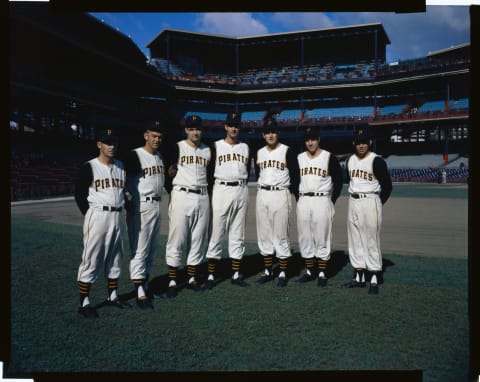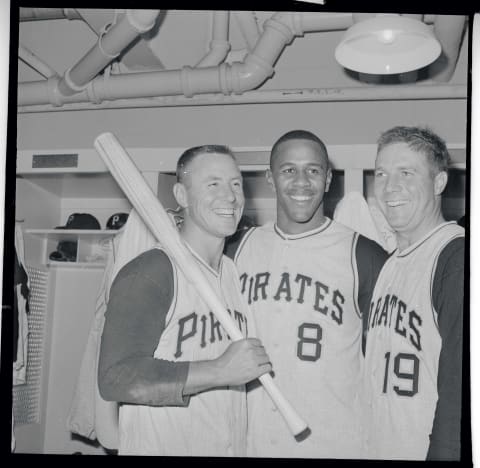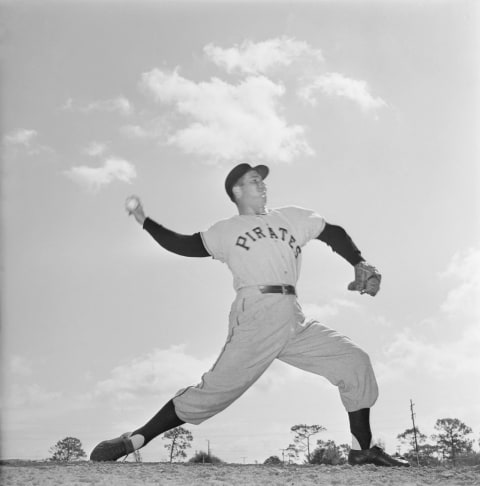Pittsburgh Pirates ace Bob Friend: What might have been


Sadly, the passing of a Pittsburgh Pirates legend drew very little fanfare recently. He deserved much, much more.
When tireless starter Bob Friend, one of the important faces of the 1960 World Champion Pittsburgh Pirates, passed away February 3 at the age of 88, he seems to have gone mercifully, in his sleep. He was at home in O’Hara Township, outside Pittsburgh.
The Pittsburgh Post-Gazette called him a “legend,” and The New York Times referred to him as a “Mainstay of Pirates Team That Stunned Yanks.” For younger fans, his death likely caused confusion, as in: “Wait, was that the golfer – he played baseball too? How old was he when he was on the tour?”
Friend’s son, also Bob, was a professional golfer on the Nationwide and PGA tours.
The pitcher’s claim to fame will likely end up resting on two facts besides his long, honorable tenure with the Pirates. He was the first pitcher to win a league ERA title with a last place team (2.83 in 44 games in 1955 as both a starter and reliever), and he was the winning pitcher in two All-Star games when those games actually mattered as much as any sports contest can – aside from those always exciting Super Bow…oh, wait, never mind.
A quick glance at Friend’s record might suggest “he wasn’t all that much,” however. When the Pirates hurler left baseball, the Dodgers’ Sandy Koufax was just completing one of baseball’s most dominant stretches ever as a pitcher (three ERAs below 2.00 and none above 2.54 in five years), and a few years later, the Cardinals’ Bob Gibson would wow the world with an ERA (1.12 in 1968) that caused the MLB mound to be lowered. Friend’s career ERA was a “respectable” 3.58.
The right-hander’s won-lost record (191-218 with the Pirates; 197-230 overall) may seem only impressive in consideration of the fact that his managers left him in games long enough to amass an impressive number of decisions. But the state of the Pittsburgh Pirates when Friend started with them in 1951, at age 20, should be considered. The verbs applied to the Bucs of the early ‘50s were only – properly – stink, stank, stunk, and will stink.

The What Might Have Been Part
As Stephen J. Nesbitt points out, Friend lost 50 games before he was 24 with the dreadful Pirates, and it doesn’t take much to imagine what might have been had the pitcher just run into a tiny bit more luck, or played with a slightly better team. 227-200, anybody? 232-195?
After retirement, Friend told an interviewer he had a great sinker – he depended on it – as well as a “hard curve,” and a reasonable change-up. To us Pirates fans who were kids and teens, he was just that guy with the congenial smile who didn’t throw as hard as Al McBean. Of course, all we knew was “over the plate,” and an occasional curve. We also knew the Pirates started to be good about 1958, and Friend was part of that. He took the ball.
In ’58, in fact, when the Pirates finished second in the National League to the Milwaukee Braves, Bob Friend tied the truly legendary Warren Spahn for the league lead in victories (22) and posted his career best WHIP, 1.042. Sure, when he was on the mound for the Pirates many years, there were men on base. But run through your head quickly those he faced repeatedly: Willie Mays, Hank Aaron, Eddie Mathews, Joe Adcock, and Ernie Banks, to name only a lethal handful.
Consider: What if Friend had played in Milwaukee? What if his 22-14 record and 274 regular-season innings pitched were available to the Braves for the ’58 World Series? Milwaukee did ultimately lose to the New York Yankees, four games to three, but Friend would certainly have started before any of the Braves pitchers not named Spahn or Lew Burdette.
Would such alternate history have given Friend a ring two years earlier than the one he won for the Pirates? For that matter, were Friend in Milwaukee rather than in Pittsburgh in ‘60, would he have picked up two rings in three years after the never-were Braves ran down the Pirates, then beat the Yankees again?

The Reality and the Man
These things did not happen, of course, and perhaps Friend’s contributions to a Milwaukee world championship or two would have never happened even if Milwaukee had added him and perhaps one more difference-maker. After all, once the hurler did get to the World Series in ’60 with the Pirates, his team went down in his starts like an MMA fighter who’d caught a roundhouse heel kick in the jaw – 16-3 and 12-0. His appearance in game seven didn’t go well either, as he surrendered two runs in relief, making his World Series ERA forever 13.50. Friend was one of the reasons the Bucs made it to that series, though, compiling an 18-12 record with a 3.00 ERA in the regular season.
More from Call to the Pen
- Philadelphia Phillies, ready for a stretch run, bomb St. Louis Cardinals
- Philadelphia Phillies: The 4 players on the franchise’s Mount Rushmore
- Boston Red Sox fans should be upset over Mookie Betts’ comment
- Analyzing the Boston Red Sox trade for Dave Henderson and Spike Owen
- 2023 MLB postseason likely to have a strange look without Yankees, Red Sox, Cardinals
It is also worth recalling MLB players of Friend’s era were real people beyond what they did on the field. They held real, non-baseball jobs, and few had the luxury of retiring at 40 with enough money for their families’ next three generations.
Bob Friend went to school in the offseason for seven years while with the Pirates, taking a degree in economics from Purdue, and served as the Allegheny County (PA) controller for nine years close on the heels of his retirement. Later he sold mutual funds, and worked for an insurance firm ten years longer than the 16 years he played major league baseball. At the water cooler, he could talk about Jackie Robinson and Pete Rose, but those who knew him would probably say Friend was too humble to do that often.
Finally, though it will likely mystify many people now, this might be noted: Bob Friend was active both in union politics (while with the Pirates) and Republican politics (later).
Next. 2019 MLB top 150 prospects. dark
While Jose Canseco was busy tweeting about aliens time-traveling with him, a real baseball player and Pittsburgh Pirates icon left the planet with a losing record to be proud of.